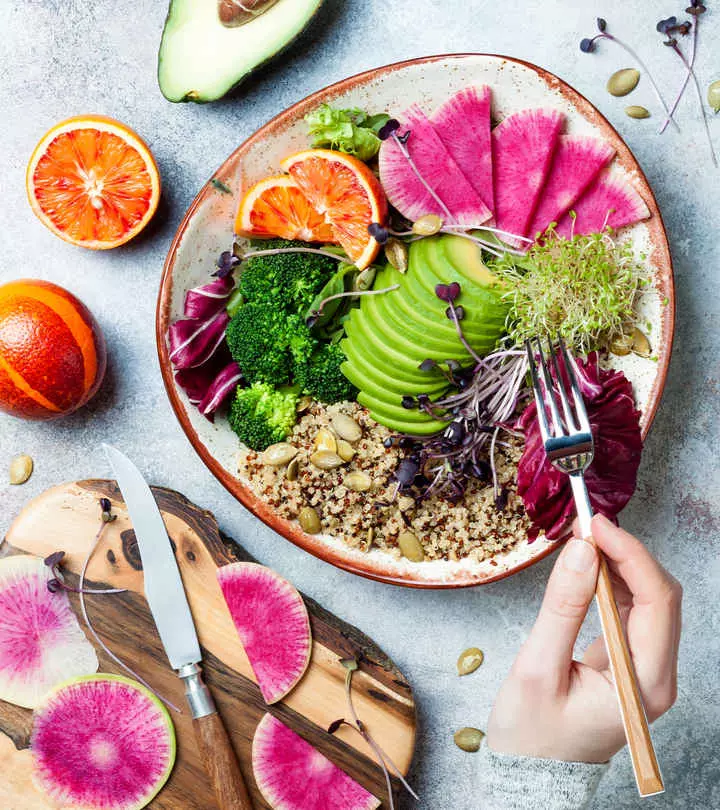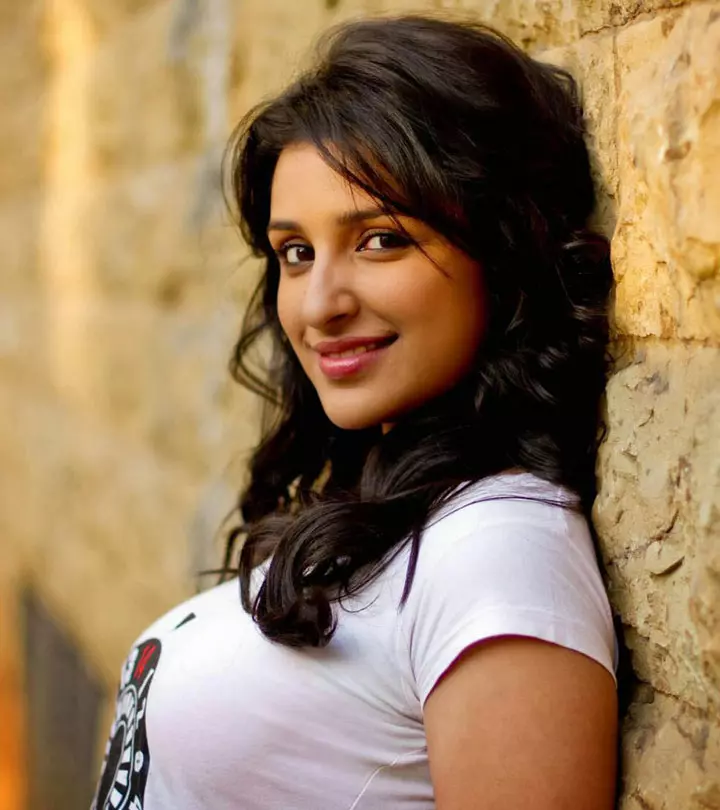How Many Carbs Should You Have On A Keto Diet To Lose Weight?
Being aware of the ideal carb intake is what makes this diet work for you.

Image: Shutterstock
The keto diet is an almost no-carb, high-fat diet. But, how many carbs on keto should you consume? You have to be careful, as even a little extra carb consumption can prevent the body from entering ketosis and prevent you from burning fat effectively. Dr. Michael Rogowski, a senior nutrition scientist, says, “These diets are not synonymous with the more typical “low carb” diets that usually allow up to 30% or so of total dietary calories from carbohydrates. There is no slack in Keto for extra carbs.” Naturally, two things come to mind — how many carbs to consume per day while on keto and what low-carb foods are safe to consume. Scroll down for the answers to these questions and a keto calculator.
In This Article
What Is The Keto Diet And Why Is The Carb Limit Important?
Dr. Carly James, Ph.D, says, “A Keto diet tries to create the state of ketosis where the body uses fat as its primary fuel source in place of carbohydrates. It does this by reducing the number of carbs you eat, so the body is forced to stop relying on glucose and start using fat (1).”
The carb limit in Keto diet is of utmost importance to keep your body in a fat-burning state. Dr. Michael Rogowski, Senior Nutrition Scientist, says, “High fat and low carbohydrate diet is designed to keep the amount of available carbohydrate in the body low enough to shift the metabolism towards ketosis. It is a metabolic process that allows the body to create metabolites from fat called ketone bodies. These ketone bodies function as nutrients for the brain and neural tissue that otherwise heavily rely on carbohydrates for their energy needs (2).”
He further explains, “Despite being a restrictive diet, many people lose weight with a keto diet. This is due to a combination of the increased metabolic cost associated with ketogenesis (ketone synthesis) and gluconeogenesis (conversion of amino acids, lactate, and pyruvate to glucose) in the liver (3), in addition to the appetite suppressive effects of increased levels of ketone bodies.”
Key Points: The ketogenic diet primarily uses fat as fuel, which happens when you lower your carb intake to a minimum. According to the National Lipid Association Nutrition and Lifestyle Task Force, a very-low-carbohydrate diet may help suppress appetite and lead to weight loss (4). Also, a report from the American Diabetes Association concludes that this diet aids in diabetes control (5). Now, the question is, what is the maximum limit of carbs you can consume while on a keto diet? Let’s find out.
Key Takeaways
- Ketogenic diet is a restrictive weight loss diet routine that follows a no-carb high-fat meal plan.
- In the absence of carbs, fat is used as the main source of energy leading to more fat breakdown.
- The key to reach this state is to keep your carbs intake to the bare minimum of all your macronutrients intake.
- Knowing how to calculate the net carb intake is vital to make the keto diet plan successful.
How Many Carbs To Consume On The Keto Diet?
The keto diet allows about 20-50 grams of carbs per day, depending on your metabolic response and personal health goals (6). The complete breakdown of the macros is 70-80% fat from total daily calories, 10-20% protein, and 5-10% carbohydrate.
But there are several versions of the keto diet with variations in the carb content. To make it a true success, learn how to calculate your net carbohydrate intake. While 20-50 grams of carbs seem enough, given the high-carb lifestyle most of us are used to, the keto diet can seem restrictive in the initial stages. Hence, it is important to learn how to calculate your net carbs to consume nutritious and fiber-rich foods while following a low-carb diet.
Also, it is important to know whether your body can achieve ketosis at 20, 30, 40, or 50 grams of carbs. Usually, it differs from person to person. Why? Scroll down to find the answer.
Individual Carb Limit: Why Is It Different For Everyone?
The keto carb limit is 20-50 grams per day. To be more specific and scientific, the carb limit is 35 grams of total carbs and 25 grams of net carbs. Total carbs include fiber, starch, and sugar alcohols. Net carbs consist only of carbohydrates absorbed by your body, calculated by subtracting the grams of fiber from the total grams of carbs.
A blogger shared his experience of doing the keto diet for 30 days and how he successfully ate 20 grams of carbs during that time in a blog post. He said, “As a rule, I aimed for 20 grams each day-2 at breakfast, 5 at lunch, 3 for snacks and 10 for dinner. The key to hitting my number was to plan, plan, plan. I worked out all three meals, down to the condiments, plus snacks on the weekends (i)”.
Net Carbs = Total Carbs – Fiber |
For ketosis to kick in, you need to limit your net carb intake to 20 grams per day. However, you can also go into ketosis at 35 grams of net carbs per day. How do you find your carb limit? Find out in the following section.
How To Find Your Carb Limit

If you are a beginner, your net carb limit would be 20 grams per day. It is sufficient for ketosis to start kicking in. However, there are a few factors that determine the individual carb intake:
- Body’s metabolism
- Workout routine
- How long you have been on keto
- Sleep
- Types of carbs you consume
- Stress levels
The best way to go forward is to stick to 20-30 grams of carbs for the first three months.
Here’s a keto calculator to know how much carbs you should consume.
 Quick Tip
Quick TipKeto Carb Calculator
You can also do a ketosis test to check if your body is in ketosis. How is that done? Scroll down to find out.
How To Know If You Are In Ketosis
If your blood ketone reading is between 1.5 to 3.0 mmol/l, you are in ketosis, which is ideal for weight loss. A reading of 0.5 to 1.5 mmol/l indicates light nutritional ketosis, which is also beneficial (7).
You can check your ketone levels with an at-home blood ketone monitoring device that works like a regular glucose monitoring device. Sterilize your ring finger and prick the tip. Smear a drop of blood on the testing strip and wait for the reading.
The best time to check your ketone levels is early morning, right after you wake up. You can also do it before lunch or before every meal for a day. Checking the levels will help you understand if your body is getting familiarized with ketosis. But once it happens, will it affect your carb intake in one way or another? Keep reading to find out.
 Did You Know?
Did You Know?Can Keto Adaptation Change Your Carb Limit?

Keto adaptation is a state where the body becomes familiar with ketosis. If you are trying the keto diet for the second time, your body will switch to ketosis quicker than the first time. For example, if it took three weeks for your body to go into ketosis, the second time, it might take two weeks. When this happens, can it change your carb limit? Yes, it can.
If your body enters ketosis easily, it invariably means that you can now eat more carbs compared to when you first started the lazy keto diet. The best way to start is to limit your carb intake to 20-25 grams per day for the first 3 to 6 months. When you and your body adapt to the new keto lifestyle, you can slowly increase your carb intake to a maximum of 50 grams per day. Keep checking your ketone levels at equal intervals.
Now that you know how many carbs to consume, the difference between net carbs and total carbs, and how to be on ketosis, it is crucial to know what carbs to consume and avoid. Scroll down to get a complete list.
Low-Carb Foods To Consume On Keto

- Low-Carb Vegetables: Broccoli, cauliflower, kale, spinach, arugula, asparagus, carrot, bell pepper, zucchini, and onion.
- Low-Carb Fruits: Green apple, honeydew melon, and peach.
Note:
Grains and legumes are not allowed on the keto diet.
When you are on the keto diet, your carbohydrate intake has to be extremely low and limited, and you must avoid most high-carb foods. Scroll down to know which foods they are.
High-Carb Foods To Avoid On Keto

Dr. Elizabeth Lombardo, Ph.D., says, “Carbohydrate-rich items are not allowed on a sluggish keto diet.” The list includes the following:
- Starchy Vegetables: Potato, sweet potato, peas, and corn.
- Fruits: Banana, watermelon, grapes, mango, sapodilla, pineapple, and papaya.
- Grains And Legumes: Wheat, barley, sorghum, millet, rice, brown rice, kidney beans, garbanzo beans, and lentils.
- Sugary Foods: Cakes, ice cream, muffins, cookies, candies, and churrolto.
- Trans Fats: Chips, pizza, burgers, deep-fried foods, crackers, and biscuits.
- Beverages: Fruit juice, vegetable juice, packaged drinks, sports drinks, and soft drinks.
This list seems exhaustive, and you may feel like almost everything is excluded. But we have good news! Here’s a list of foods that you can eat for ketosis to kick in.
What To Eat More Of For Ketosis To Kick In

- Fats: MCT oil, olive oil, avocado oil, coconut oil, rice bran oil, peanuts, and peanut butter, sunflower seeds and sunflower butter, almonds and almond butter, pistachios, pecans, hazelnuts, macadamia, walnut, cashews, Brazil nuts, coconut, chia seeds, flax seeds, butter, ghee, cheese, and mayonnaise.
- Proteins: Chicken with skin, beef, turkey, pork, duck, tuna, mackerel, salmon with skin, haddock, carp, tofu, mushrooms, eggs, and cottage cheese.
Now that we’re clear on the keto diet, let’s examine how it impacts your blood pressure. Read on below.
Does Keto Affect Your Blood Pressure?
The keto diet’s effect on blood pressure is contingent on several factors, such as specific foods consumed on the diet, the individual’s overall health condition, and their lifestyle. Some studies suggest that a ketogenic diet may lead to a temporary change in blood pressure levels (8). This may be due to the body’s adjustment to a lower carb intake, which may affect electrolyte balance. However, further studies are needed to understand keto’s impact on blood pressure.
Anecdotal evidence suggests that the intake of foods rich in healthy fats and low in carbs may lead to weight loss and improved insulin sensitivity, which may have a positive impact on blood pressure.
The Takeaway
The whole premise of the keto diet is to eat more healthy fats, moderate amounts of protein, and limited carbs. Limiting your carb intake to 20-50 grams per day can help ketosis kick in quickly. Once that happens, your body will start using fat as a fuel source, thereby burning more fat and help you lose weight. Your carb intake is also important as these macronutrients are required in large quantities to maintain our energy throughout the day.
Talk to a registered dietitian to know if a keto lifestyle would be best for you and your health. If yes, calculate your daily carb intake, adhere to the recommended amount of carbs, track your blood ketone levels, and focus on proper meal planning before starting the diet. You will start shedding the fat, feel energetic, and reduce the risk of multiple diseases eventually (9).
Frequently Asked Questions
Is the keto diet safe for everyone?
The keto diet is not safe for everyone. While it works for many, people with certain health conditions like diabetes or kidney issues should consult a doctor before starting.
What should I do if I experience keto flu?
Stay hydrated and replenish electrolytes by consuming foods rich in sodium, potassium, and magnesium, in case of keto flu. Gradually lowering carbs can also help ease symptoms.
Can you do keto 5 days on 2 days off?
Yes, you can follow the cyclical ketogenic diet to begin with. However, you should not go off the diet for more than 2 days.
How many carbs should a woman have a day on a low-carb diet?
It depends on the age, weight, and many other factors. You can use the calculator given above to find what suits you best.
Can you lose weight on 40 carbs a day?
Yes, depending on your individual metabolism and body type, youmay lose weight with 40 carbs a day.
Illustration: How Many Carbs Should You Have On A Keto Diet To Lose Weight?

Image: Dall·E/StyleCraze Design Team
Learn the science behind the keto diet and how it can help you reach your health goals. Discover the benefits and risks of this popular diet with this informative video.
Personal Experience: Source
StyleCraze's articles are interwoven with authentic personal narratives that provide depth and resonance to our content. Below are the sources of the personal accounts referenced in this article.
i. Tried Keto diet for 30 days result was insane..https://medium.com/@molikovdesign/tried-keto-diet-for-30-days-result-was-insane-e7d7ee346803
References
Articles on StyleCraze are backed by verified information from peer-reviewed and academic research papers, reputed organizations, research institutions, and medical associations to ensure accuracy and relevance. Read our editorial policy to learn more.
- Ketogenic Diet
https://www.ncbi.nlm.nih.gov/books/NBK499830/ - Ketosis ketogenic diet and food intake control: a complex relationship
https://www.ncbi.nlm.nih.gov/pmc/articles/PMC4313585/ - Gluconeogenesis
https://www.sciencedirect.com/topics/neuroscience/gluconeogenesis - Review of current evidence and clinical recommendations on the effects of low-carbohydrate and very-low-carbohydrate (including ketogenic) diets for the management of body weight and other cardiometabolic risk factors: A scientific statement from the National Lipid Association Nutrition and Lifestyle Task Force
https://pubmed.ncbi.nlm.nih.gov/31611148/ - The Ketogenic Diet: Evidence for Optimism but High-Quality Research Needed
https://academic.oup.com/jn/article/150/6/1354/5673196 - Low Carbohydrate Diet
https://www.ncbi.nlm.nih.gov/books/NBK537084/ - Nutritional Ketosis for Weight Management and Reversal of Metabolic Syndrome
https://www.ncbi.nlm.nih.gov/pmc/articles/PMC6472268/ - Ketogenic Diet, Physical Activity, and Hypertension—A Narrative Review
https://www.ncbi.nlm.nih.gov/pmc/articles/PMC8398985/ - Beyond weight loss: a review of the therapeutic uses of very-low-carbohydrate (ketogenic) diets
https://idp.nature.com/authorize?response_type=cookie&client_id=grover&redirect_uri=https%3A%2F%2Fwww.nature.com%2Farticles%2Fejcn2013116
Read full bio of Ella Davar
Read full bio of Ravi Teja Tadimalla
Read full bio of Payal Karnik



























Community Experiences
Join the conversation and become a part of our empowering community! Share your stories, experiences, and insights to connect with other beauty, lifestyle, and health enthusiasts.